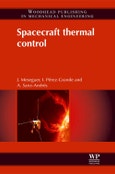Table of Contents
List of figures
List of tables
Foreword
About the authors
Chapter 1: The space mission
Abstract:
1.1 Introduction
1.2 Mission analysis and design
1.3 Elements of a space mission
1.4 Types of space missions
1.5 Spacecraft design: subsystems and payloads
Chapter 2: Space environment
Abstract:
2.1 Introduction
2.2 Ground environment
2.3 Launch thermal environment
2.4 In-orbit thermal environment
2.5 Other in-orbit environmental aspects
Chapter 3: Keplerian orbits
Abstract:
3.1 One-body problem
3.2 The orbit in space
3.3 Orbit perturbations
3.4 Lighting conditions
3.5 Types of orbits
Chapter 4: Conductive heat transfer
Abstract:
4.1 Introduction
4.2 Fourier's law
4.3 The heat diffusion equation
4.4 Boundary and initial conditions
4.5 Conductive shape factors
4.6 Numerical methods in heat conduction
Chapter 5: Thermal radiation heat transfer
Abstract:
5.1 Nature of thermal radiation
5.2 Blackbody radiation
5.3 Properties of real surfaces
5.4 View factors
5.5 Radiation exchange between opaque, diffuse, and grey surfaces in an enclosure
Chapter 6: Thermal control surfaces
Abstract:
6.1 Introduction
6.2 Thermal control coatings
6.3 Thermal coating degradation
Chapter 7: Insulation systems
Abstract:
7.1 Introduction
7.2 Multilayer insulations
7.3 Foams
Chapter 8: Radiators
Abstract:
8.1 Introduction
8.2 Passive cryogenic radiant coolers
8.3 Thermal efficiency
8.4 V-groove radiators
Chapter 9: Louvers
Abstract:
9.1 Introduction
9.2 Description of louvers
9.3 Performance of louvers
9.4 MEMS louvers
Chapter 10: Mechanical interfaces
Abstract:
10.1 Introduction
10.2 Thermal contact conductance
10.3 Thermal fillers
10.4 Thermal braids and straps
Chapter 11: Heat pipes
Abstract:
11.1 Introduction
11.2 Capillarity
11.3 Working fluids
11.4 Wicks
11.5 Other capillary heat transfer designs
Chapter 12: Phase change capacitors
Abstract:
12.1 Introduction
12.2 Characteristics of phase change materials
12.3 Materials data
12.4 Phase change material technology
12.5 The performance of phase change materials
Chapter 13: Heaters
Abstract:
13.1 Introduction
13.2 Electrical heaters
13.3 Radioisotope heat sources
13.4 Heat switches
Chapter 14: Pumped fluid loops
Abstract:
14.1 Introduction
14.2 Mechanically pumped single-phase fluid loops
14.3 Mechanically pumped two-phase fluid loops
Chapter 15: Thermoelectric cooling
Abstract:
15.1 Introduction
15.2 Fundamentals
15.3 Space applications
Chapter 16: Cryogenic systems
Abstract:
16.1 Introduction
16.2 Refrigerating systems
Chapter 17: Thermal protection systems
Abstract:
17.1 Introduction
17.2 Ablative systems
17.3 Radiative systems
17.4 Other thermal protection techniques
Chapter 18: Thermal control design
Abstract:
18.1 Design objectives and requirements
18.2 Design process
18.3 Load cases
Chapter 19: Thermal mathematical models
Abstract:
19.1 Introduction
19.2 Thermal analysis software
Chapter 20: Thermal control testing
Abstract:
20.1 Introduction
20.2 Testing objectives
20.3 Model philosophy
20.4 Development tests
20.5 Thermal balance tests
20.6 Thermal vacuum tests
20.7 Test facilities
Chapter 21: Conclusion
Index








